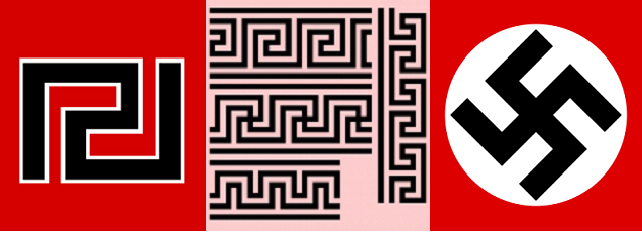Of swastikas, meanders and the mapping of complexity
[ by Charles Cameron — a meander from the symbolism of the Greek neo-Nazi party to the complex flow of the great Mississippi River ]
.
As every red (or blue) blooded conspiracist knows, there’s a swastika-shaped building on the US Naval Amphibious Base Coronado near San Diego, CA.
That might of course mean the US Navy is under the spell of Hinduism or Buddhism, each of which makes use of the swastika for reasons that have nothing to do with the Nazis and more perhaps to do with simple geometric shapes and their near-universal use in rituals:
*
I mention this, because symbolism is important, because the Greek right-wing party that did well in the recent elections has a flag that has been compared with the Nazi swastika, and because conspiracy theories, though informative markers of shifts in the collective unconscious in their own right, are also useful tools in the shame and blame game.
The Greek party concerned (Chryssi Avghi or Golden Dawn) points out that the central symbol of its flag (left) is taken from an ancient Greek “meander” (note similarities in the various common designs, middle) and not from the Nazi flag (right) – even though it’s curious that they choose the same black on white on red colors, isn’t it?
In my view the flag is suggestive, not conclusive: it’s their holocaust denial that proves the point.
*
Anyway, it’s likely that none of that would have been interesting enough for me to post it, had my quirky researches not also pointed me to a far more interesting graphic.
Regular readers here will remember that I have an interest in graphical representations of complexity, and posted a piece titled Of railroad tracks and polyphonic thinking a while ago, in which I took the metaphor of trains of thought far too literally, and used railroad imagery to suggest a few ideas about complexity…
My researches into the Greek “meander” patterns were intriguing — but it was stumbling across this image from a post at the Ontario-based Onsite Review that decided me (and I think that’s the right usage, we are decided, we don’t decide) that I really did need to make this post.
Consider: it’s the mighty Mississippi, seen as it meanders across time:
The Onsite Review’s attribution is to Harold N. Fisk, Ancient Courses. Mississippi River Meander Belt, 1944. Their comment for this image reads:
The greek key pattern is sometimes called the meander, after the Maeander River, now called the Büyük Menderes River that flows from central Turkey to the Aegean. It winds through the Maeandrian plain in the manner of most prairie rivers, cutting into soft banks and creating oxbows.
We know a certain amount scientifically about river meanders, just as we know quite a bit about perturbations in the flow of liquids — but not enough, never quite enough to know where the river of time will take us next.
The map above illustrates the flows of a fairly simple complexity: take a good look at it. The thought-flows of a human are liable to be far more complex.






